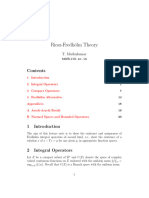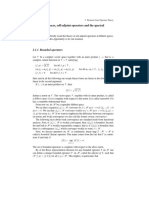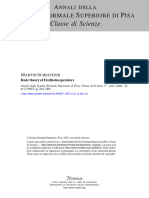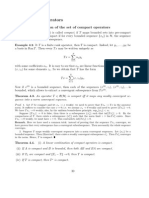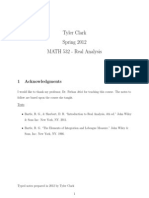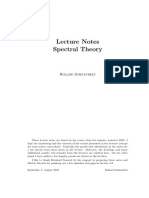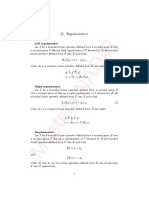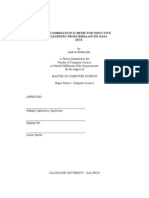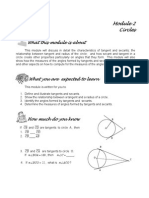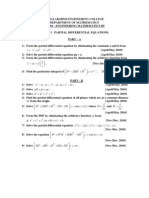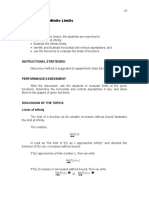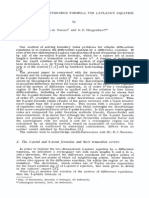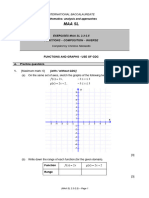§2. Compact Operators
Compact linear operators
A linear operator A de…ned from a normed space E into a normed space
F is called a compact linear operator or completely continuous linear opera-
tor if for every bounded subset of E; the image A( ) is relatively compact
in F: In other words, the closure A( ) is compact.
Theorem 1 (Compactness criterion)
A linear operator A de…ned from a normed space E into a normed space
F is called a linear compact operator or completely continuous linear opera-
tor if and only if for every bounded sequence 'n in E; the sequence A'n in
F has a convergent subsequence A'nk :
Proof
Let 'n be a bounded sequence in E; since the operator A is compact,
then the set fA'n g is relatively compact in F where this property shows
that A'n contains a convergent subsequence.
Conversely, let us consider any bounded subset in E and let n be any
sequence in A( ): Then there exists a bounded sequence 'n in ; such that
n = A'n :
By assumption, A'n = n contains a convergent subsequence nk in F:
Thus A( ) is relatively compact, because for any bounded sequence n in
A( ) there exits a convergent subsequence nk in F: In other words, for all
bounded set E; the set A( ) is relatively compact in F: Hence A is
compact.
Theorem 2
The linear combination A = A1 + A2 of compact operators A1 and
A2 is a compact operator, for every scalars and :
Proof
Let 'n be a bounded sequence in E and let A'n be a sequence in F;
then
A'n (x) = A1 'n (x) + A2 'n (x); with 'n 2 E; n 2 N:
1
The operators A1 and A2 are compact, one can extract from A1 'n and
A2 'n two convergent subsequences which give by their sum a convergent
subsequence of A'n : Hence A is compact.
Theorem 3
The product AB of two bounded operators A and B is compact if either
of operators A or B is compact.
Proof
Let 'n be a bounded sequence in E; then if we consider B as a bounded
operator the sequence B'n (x) is bounded, and from the compactness of
the operator A gives a convergent subsequence A B'nk (x) of A(B'n (x)):
Hence the operator AB is compact.
On the other hand, if we consider B as a compact, one can extract from
B'n (x) a convergent subsequence B'nk (x); and from the boundedness of
the operator A gives the convergence of the sequence A(B'nk (x)): Hence
the operator AB is compact.
Theorem 4
The sequence An of compact operators de…ned from a normed space E
into a Banach space F converges uniformly to an operator A; say,
lim kAn Ak = 0:
n!1
Then the limit operator A is compact.
Proof
Let 'n be a bounded sequence in E; the operator A1 is compact, then
one can extract from the sequence A1 'n a convergent subsequence, say '1n
a subsequence from 'n such that A1 '1n converges.
In the same way, taking '1n as a bounded sequence so, we can extract
from the sequence A2 '1n a convergent subsequence , say '2n a subsequence
from '1n such that A2 '2n converges.
Noting that, we obtain from the bounded sequence 'n a subsequence
'2n such that A1 '2n and A2 '2n both converge.
Continuing in this way, we see that, for the compact operators A1 ; A2 ; ::; Ap ;
there exists a nested subsequences
'pn ::::'2n '1n 'n ;
such that, the sequences Ak 'pn converge for all k = 1; 2; :::; p:
2
In order to show the compactness of the operator limit A; we must use
the completeness of the space F and showing that the sequence A'pn is
Cauchy sequence.
Noting that the sequence 'n is bounded, say k'n k M for all n: Hence
k 'pn k M for each n and p: Choose n = p so that
"
kAn Ak < :
3M
Since the sequence An 'pn is Cauchy, because it converges, so there exists N
such that, for all p > N and q > N; we get
"
An 'pn An 'qn < :
3
Hence, we obtain
k A'pn A'qn k = A'pn A'qn + An 'pn An 'pn + An 'qn An 'qn
A'pn An 'pn + An 'pn An 'qn + An 'qn A'qn
kAn Ak 'pn + An 'pn An 'qn + kAn Ak 'pn
" " "
M+ + M = ":
3M 3 3M
Remembering that, due to the completeness of the space F; the Cauchy
sequence A'pn converges as a subsequence of A'n where 'pn is a subse-
quence of an arbitrary bounded sequence 'n : Hence the compactness of the
operator A:
Theorem 5 (…nite dimensional range)
Let A be a bounded operator de…ned from E into F with the range A(E)
has a …nite dimension, dim A(E) < 1 then the operator A is compact.
Proof
Indeed, for all bounded set in E; the range A( ) is a bounded set
in the …nite dimensional space A(E): Hence A( ) is relatively compact, it
follows that A is a compact operator.
Theorem 6 (…nite dimensional domain)
Let A be a bounded operator de…ned from E into F with the domain E
has a …nite dimension, dim E < 1 then the operator A is compact.
Proof
3
Indeed, the space E has a …nite dimension, dim E < 1 implies the …nite
dimensional range A(E); say
dim A(E) dim E;
it follows that, A is a compact operator.
Lemma 1
Let F be a closed subspace in the normed space E such that, F = 6 E
then there exists an element ' 2 E with k'k = 1 such that, for all 2 F;
we have
k' k ; with 0 < < 1
Proof
Indeed, let f be an element of E such that f 2
= F then, we get
inf kf hk = > 0;
h2F
choosing an element g belongs to F such that,
kf gk :
De…ne the vector ' by
f g
'= ;
kf gk
this vector ' has a unit norm k'k = 1; besides, for all 2 F we get
f g
k' k =
kf gk
f g (kf gk)
=
kf gk kf gk
1
= kf (g + (kf gk ))k
kf gk
:
kf gk
Theorem 7
The identity operator I de…ned from a normed space E into E is compact
if and only if the space E has a …nite dimension.
4
Proof
let '1 be an element of E; such that k'1 k = 1; then the set of …nite
dimension F1 = spanf'1 g represents a closed subspace of E: So there exists
1
an element '2 2 E; such that k'2 k = 1 and k'1 '2 k 2 : By the same
way we take a closed subspace F2 = spanf'1 ; '2 g and …nding an element
1 1
'3 2 E such that k'2 k = 1 with k'1 '3 k 2 and k'2 '3 k 2 : One
repeat the same procedure until the obtaining of a sequence 'n verifying
k'n k = 1 and k'm 'n k > 21 ; for all m 6= n:
Noting that, the sequence 'n is bounded but does not contain any con-
vergent subsequence. Hence the operator I'n = 'n is not compact.
Corollary 1
The closed unit ball B(0; 1) in the normed space E of in…nitely dimen-
sional is not compact.
Indeed, B(0; 1) is bounded but cannot be compact; thus
I (B(0; 1)) = B(0; 1);
is not relatively compact. In other words B(0; 1) is not compact.
Corollary 2
A bounded operator A in a normed space E is not generally a compact
operator.
Indeed, see the identity operator A = I in the in…nitely dimensional
normed space E is not compact.
Theorem 8
The integral operator A de…ned from C( ) into C( )
Z
A'(x) = k(x; y)'(y)dy; x; y 2
with continuous kernel k(x; y) is a compact operator.
Proof
Let G be a bounded set of C( ) then, for each ' 2 G; there exists
M > 0, such that
5
k'k M;
besides, for all x 2 and ' 2 G; we get
Z
jA'(x)j = k(x; y)'(y)dy
max jk(x; y)j M mes ( ) :
x;y2
It follows that A(G) is bounded.
By assumption, the kernel k(x; y) is continuous over the compact ;
thus it is uniformly continuous and therefore
"
8" > 0; 9 > 0; 8x; y; z 2 ; jx yj < ) jk(x; z) k(y; z)j < :
M mes ( )
Hence, for each ' 2 G and x; y 2 ; with jx yj <
Z
jA'(x) A'(y)j = (k(x; z) k(y; z))'(z)dz
"
< M mes ( ) = ":
M mes ( )
This relation expresses that A(G) is equicontinuous. Hence A(G) is
relatively compact, so by Arzela-Ascoli’s theorem A is compact.
Weakly singular kernel
The kernel k(x; y) is said to be weakly singular if it is de…ned continuous
on Rn Rn for all x 6= y and there exist a positive constants M
and 2]0; n] such that
M
jk(x; y)j < ; x; y 2 ; x 6= y:
jx yjn
In other words,
M
8x; y 2 ; x 6= y; 9M > 0; jk(x; y)j < ; 0< n
jx yjn
Theorem 9
The integral operator A de…ned from C( ) into C( ) with weakly con-
tinuous kernel is a compact operator.
6
proof
Noting that, the integral operator
Z
A'(x) = k(x; y)'(y)dy; x; y 2
exists as an improper integral, due to the weakly continuous kernel
n
jk(x; y)'(y)j M k'k jx yj ;
further,
Z Z d
n n n 1 !n
jx yj dy !n d = d ;
0
where ! n designates the surface area of the unit sphere in Rn and d the
diameter of the set :
Let us construct a sequence of compact operators An which converges to
the integral operator A; such that
lim kAn Ak = 0:
n!1
choosing now a linear continuous function h de…ned on [0; 1[ into R; by
8 1
>
< 0
> if 0 t
2
h(t) = 1 ;
> 2t 1 if t 1
>
: 2
1 if 1 t<1
The function kn (x; y) de…ned on into R; by
h(n jx yj)k(x; y) if x 6= y
kn (x; y) =
0 if x = y
is a continuous kernel for each n 2 N: Hence the integral operators An such
that Z
An '(x) = kn (x; y)'(y)dy; x; y 2 ;
are compact.
7
Besides, for all x 2 ; we get
Z
jAn '(x) A'(x)j = [kn (x; y) k(x; y)]'(y)dy
Z
= fh(n jx yj) 1g k(x; y)'(y)dy
1
\jx yj< n
Z 1
n
n n 1
M k'k ! n d
0
!n
M k'k :
n
It is simple to see that the convergence An ' to A' is uniform, so it
follows that,
!n
kA An k M ! 0; when p ! 1;
n
and thus A is compact operator.
Theorem 10
The integral operator A de…ned from the normed space C(@ ) into C(@ )
with continuous or weakly continuous kernel is a compact operator, where
under @ we designate a regular boundary of the set :
8
Bibliography
[1] M. NADIR. Cours d’analyse fonctionnelle, université de Msila 2004.
Address. Prof. Dr. Mostefa NADIR
Department of Mathematics
Faculty of Mathematics and Informatics
University of Msila
28000 ALGERIA
E-mail: mostefanadir@yahoo.fr


